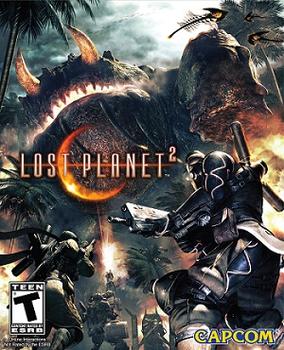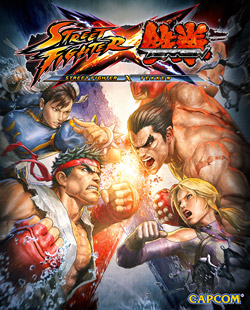
Gears of War is a 2006 third-person shooter video game developed by Epic Games and published by Microsoft Game Studios. It is the first installment of the Gears of War series, and was initially released as an exclusive title for the Xbox 360 in November 2006. A Microsoft Windows version, developed in conjunction with People Can Fly, was released in November 2007. The game's main story, which can be played in single or co-operative play, focuses on a squad of troops who assist in completing a desperate, last-ditch attempt to end a war against a genocidal subterranean enemy, the Locust, and save the remaining human inhabitants of their planet Sera. The game's multiplayer mode allows up to eight players to control characters from one of the two factions in a variety of online game modes. Gameplay features players using cover and strategic fire in order to win battles.

Virtua Tennis 3, known in Japan as Sega Professional Tennis: Power Smash 3, is the second arcade game sequel to Sega's tennis game franchise, Virtua Tennis. The arcade version of Virtua Tennis 3 is powered by the PC-based Sega Lindbergh arcade system board. Ports for the PC, Xbox 360, PlayStation Portable and PlayStation 3 consoles are also available with a traditional collection of tennis minigames that the home versions of Virtua Tennis are known for. In 2009, Sega updated and re-created Virtua Tennis 3 in Virtua Tennis 2009.

Guitar Hero II is a music rhythm video game developed by Harmonix and published by RedOctane for the PlayStation 2 and Activision for the Xbox 360. It is the second main installment in the Guitar Hero series and is the sequel to 2005's Guitar Hero. It was first released for the PlayStation 2 in November 2006, and then for the Xbox 360 in April 2007, with additional content not originally in the PlayStation 2 version.

The Elder Scrolls IV: Shivering Isles is the second expansion pack for the role-playing video game The Elder Scrolls IV: Oblivion. Announced on January 18, 2007, the expansion was developed, published, and released over the Xbox Live Marketplace by Bethesda Softworks; its retail release was co-published with 2K Games. It was released for Microsoft Windows in a boxed retail edition on March 26, 2007, while the Xbox 360 version was released digitally on the Xbox Live Marketplace. Shivering Isles takes place on the eponymous isles ruled by the Daedric Prince of Madness, Sheogorath. The player becomes Sheogorath's protégé, and together they try to defeat the Daedric Lord of Order, Jyggalag, thus preventing the isles from being destroyed; this main quest can be ignored for as long as the player wishes to interact with the new world.

Pinball FX is a pinball machine video game for the Xbox 360. It was developed by Zen Studios and published by Microsoft Game Studios. It was released on April 25, 2007 via the Xbox Live Arcade service. The game features three tables, with six more available as downloadable content, leaderboards and online multiplayer. A sequel to the game, Pinball FX 2 was released on October 27, 2010.

Super Street Fighter II Turbo HD Remix is a two dimensional fighting game released using the PlayStation Store and Xbox Live Arcade download services. A physical copy of the game was later released as part of Capcom Digital Collection. It is a remake of Super Street Fighter II Turbo featuring the original game and a high definition version using graphics drawn by UDON Entertainment, and arranged music by OverClocked ReMix members. The game was designed by Backbone Entertainment's David Sirlin to be the sixth definitive version of Street Fighter II, although it is in fact the seventh, being released after Hyper Street Fighter II.

Klei Entertainment Inc. is a Canadian video game development company located in Vancouver, British Columbia. Klei was formed in July 2005 by Jamie Cheng. Their best-known titles include Don't Starve and Oxygen Not Included.

Torchlight is an action role-playing hack and slash dungeon crawler video game developed by Runic Games and published by Perfect World, released for Windows in October 2009. The fantasy-themed game is set in the fictional town of Torchlight and the expansive caverns and dungeons nearby, which adventurers explore to collect valuable loot and battle hordes of monsters. Following the October 2009 digital distribution release, a Windows retail box version was released in the U.S. in January 2010 by Encore, Inc, and JoWooD Entertainment published a retail box in Europe in April 2010. A port for OS X was developed by World Domination Industries and released through Steam on May 12, 2010. Runic Games and World Domination Industries developed a port for Xbox Live Arcade which was released on March 9, 2011. A Linux port was released as part of the game's inclusion in the Humble Indie Bundle 6.
MT Framework is a game engine created by Capcom. "MT" stands for "Multi-Thread", "Meta Tools" and "Multi-Target". While initially MT Framework was intended to power 2006's Dead Rising and Lost Planet: Extreme Condition only, Capcom later decided for their internal development divisions to adopt it as their default engine. As a result, the vast majority of their internally developed video games for the PlayStation 3 and Xbox 360 platforms were created on it, including four new titles and three remastered ports of past titles in the Resident Evil series. The visuals of the first games built with the engine were well received, and MT Framework has also won a CEDEC award.

Lost Planet 2 is a third-person shooter video game developed and published by Capcom and Beeline Interactive, Inc. The game is the sequel to Lost Planet: Extreme Condition, taking place ten years after the events of the first game, on the same planet. The game was developed for BlackBerry, PlayStation 3, Xbox 360 and Microsoft Windows. Originally set to be released in early 2010, Capcom delayed the game's consoles release to May 11, 2010 in North America and Europe, May 13 in Australia and May 20 for Japan, while the BlackBerry version was released worldwide on April 28 and the Microsoft Windows version was released in October that year. The title sold more than 1.5 million copies worldwide.

Blood Bowl is a 2009 fantasy sports video game developed by Cyanide, loosely based on American football, and adapted from the board game of the same name, which is produced by Games Workshop, using the CRP ruleset. It was released for Microsoft Windows, Xbox 360, Nintendo DS, PlayStation Portable, iOS, and Android.

Galactic Command is the third series of space exploration video games developed by 3000AD, Inc.
Lost Planet is a video game series of third-person shooters published by Capcom. The series follows a number of protagonists on E.D.N III, a planet in the process of an ice age, as they survive and fight the environment, various alien creatures and those planning to colonize the planet.

Street Fighter X Tekken is a crossover fighting game developed and published by Capcom and released in March 2012 for the PlayStation 3 and Xbox 360, in May for Windows and in October for the PlayStation Vita. The game features characters from both the Street Fighter franchise and Namco's Tekken series. In the game, each player selects two characters respectively and face other as duos in tag team fighting matches, with the objective to knock out one of the members from the opposing team. In addition to the game's multiplayer modes, the game also features a single-player Story mode with a plot revolving around a mysterious object called the "Pandora".

Lost Planet 3 is a third-person shooter action-adventure video game developed by Spark Unlimited and published by Capcom for Microsoft Windows, PlayStation 3 and Xbox 360. The game is the prequel to Lost Planet: Extreme Condition and Lost Planet 2 and takes place on the same planet of E.D.N. III. The game takes a more story-driven narrative approach to the campaign similar to the first game. Unlike the previous games in the series, which were developed internally by Capcom, the game was developed externally by Spark Unlimited with Matt Sophos serving as game director, though series creator Kenji Oguro was still attached as franchise creative director.














